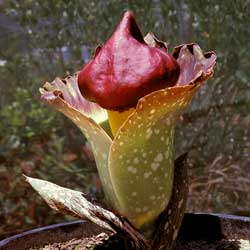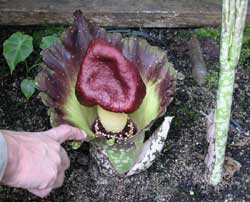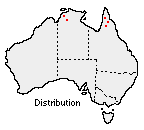Amorphophallus paeoniifolius
 |
 |
Elephant Yam
Amorphophallus paeoniifolius (Dennst.) Nicolson
Amorphophallus paeoniifolius, the Elephant Yam, belongs to the Aroid family, Araceae. This family contains many plants recognised as having horticultural appeal such as the Arum Lilies, Monstera, Syngonium and Philodendron. The family is characterised by its inflorescence, consisting of a fleshy spike of small flowers (spadix) usually subtended by a large bract (spathe).
 Amorphophallus
paeoniifolius occurs through the tropics, from India to New Guinea and to
Australia where it is found in tropical Queensland and Northern Territory in
seasonally dry areas. The species was previously called Amorphophallus campanulatus.
Amorphophallus
paeoniifolius occurs through the tropics, from India to New Guinea and to
Australia where it is found in tropical Queensland and Northern Territory in
seasonally dry areas. The species was previously called Amorphophallus campanulatus.
This plant produces a single inflorescence followed by a solitary leaf. The plant is deciduous, dying back to a large underground corm, weighing up to 8kg, after the growing season.
Some people regard the inflorescence as bizarre. It comprises a large spadix crowned with a bulbous purple knob, encircled by a fleshy purple and green-blotched spathe up to 50cm wide. On successful pollination of the female flowers the spadix can extend to 2m tall. The fresh inflorescence emits an odor reminiscent of rotting flesh to attract pollinating carrion flies and beetles.
The solitary leaf resembles a small tree. The leaf blade is much divided into hundreds of leaflets and can reach over 1m wide. This blade sits atop a thick fleshy stem up to 13cm diameter and 2m tall. The pustular surface of the stem is attractively blotched with paler shades of green.
Amorphophallus paeoniifolius is quite hardy in tropical areas when planted in rich, well-drained soil in a sheltered, humid position. In temperate areas the plant can be grown successfully as a container specimen. A pot twice the diameter of the corm should be selected and filled with rich, well-drained potting mix.
The corm needs to be planted well below the soil surface to give the plant stability. Ample water is required during the growing season but the amount can be reduced dramatically during dormancy. Corms of potted specimens can be removed from the pot and stored dry to prevent frost damage. The occasional application of a high phosphorus fertilizer (NPK 15,30,15) will ensure maximum growth and health of the plant.
The plant can be propagated from offsets of the corm or by fresh seed sown in a slightly acidic seed raising mix. As most of the starch stored in the corm is used to produce the leaf, transplanting should not be attempted until the leaf has wilted and the new corm developed.
The corms of some varieties are edible and grown as food crops in several Asian countries, especially Indonesia.
The main horticultural pests affecting Amorphophallus paeoniifolius is nematodes.
Text by Tony Roberts (2002 Botanical Intern)
Name meaning: Amorphophallus paeoniifoliusAmorphophallus - Deformed or shapeless penis. paeoniifolius - Peony-like (genus Paeonia) foliage. |
![An Australian Government Initiative [logo]](/images/austgovt_brown_90px.gif)

